Evolution in the Reconstruction of Diplodocus
Diplodocus has always held a significant position in the hearts of dinosaur palaeontologists, as it was one of the very first genera to ever be formally recognised and described. Following, are some images and attempted reconstructions from Hutchinson (1917), and by comparison some excellent recent research by Taylor et al. (2009) on posture in Diplodocus carnegiei (or carnegii). I just figured it would be cool to show how mechanical interpretations and life reconstructions had changed over the years, since from dinosaurs were first mounted to now where more complex biomechanical modelling procedures are being utilised.
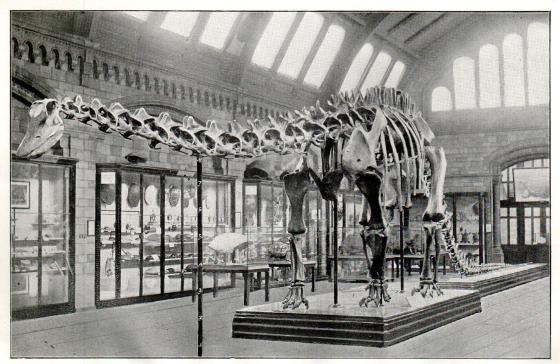
The following is a model reconstruction made from plaster based on the above skeleton. The tail rests on the ground, the neck is concave downwards and held-sub-horizontally, and the limbs are situated laterally to the trunk. Hutchinson (1917) explicitly says that despite this odd arrangement, Diplodocus did not crawl around on the ground like a lizard or crocodile.
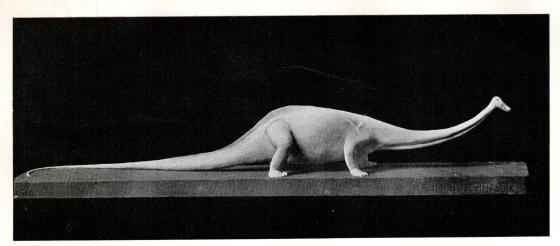
Following the above reconstruction, there is a simple reconstruction of the pelvic girdle and hind-limb provided. The femur and the tibia/fibula are perpendicular, with the pes also perpendicular to that to rest on a substrate. It pretty much looks like the ischium gouged a furrow whenever the animal tried to walk in this reconstruction.
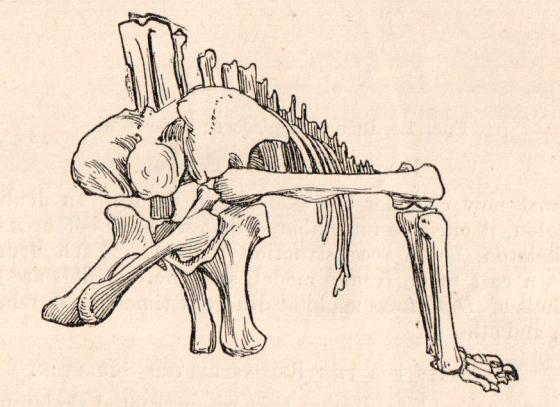
By comparison, more recent reconstructions are quite different. The following is just one of many illustrations by the talented Scott Hartman (follow @skeletaldrawing on Twitter). Note the distinct differences in posture: the legs are held vertically under (and slightly lateral) to the trunk, elevating the main body. Accordingly, the neck and tail both become more horizontal, acting as respective cantilevers with respect to the main body and the centre of gravity. Much more detail regarding stance and posture can be found on the wonderful SV-POW blog here, and in many formal publications.

Following on from reconstructions like above, the next step is to reconstruct the range of motion to discern possible ecological functions of various skeletal elements and domains. This has been done rather successfully by H. Mallison with Plateosaurus (Part 1 and Part 2). Hutchinson (1917) attempted a very rudimentary interpretation of this, as shown below.
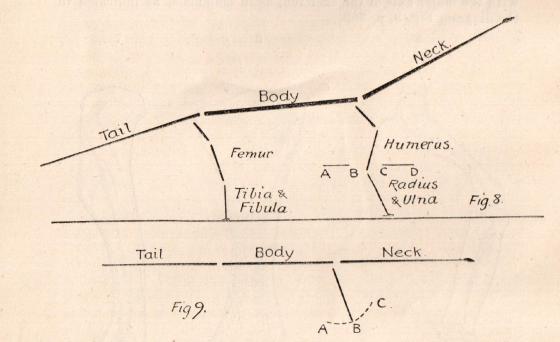
Yeah, ok, it’s pretty basic. Some progress has been made in this field with sauropods however, notably that from Taylor et al. (2009) with regards to Brachiosaurus brancai, as shown below (edit: the Tendaguru Brachiosaurus brancai is now regarded as Giraffatitan brancai, Taylor, 2009; see comment below). Obviously Brachiosaurus is not Diplodocus, but it illustrates the point nicely.
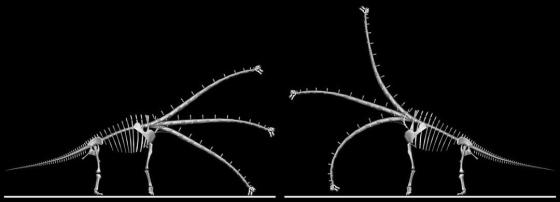
Digital reconstruction is proving to be a pretty useful tool in imaging and interpreting life positions of dinosaurs and other extinct organisms. More recently, vertebrate palaeontologists, combined with mechanical modellers and zoologists have began to map muscles on to these digital skeletons using modern analogues and the ‘extant phylogenetic bracket‘ theory, to gain a significantly more detailed reconstruction and make more valid interpretations about extinct archosaur mechanics.
As computing technology has developed, palaeontologists have kept pace and are finding ever more elaborate methods to aid in understanding the mechanics, physiology, and ecology of extinct organisms. It’s an exciting field, with lots of promise for the future!
Note: I feel like a tit. Spent a whole year working/studying in the NHM London, and don’t have a single photo of the focal Diplodocus specimen there, Dippy. Oops.
Bates, K. T., Maidment, S. C., Allen, V. and Barrett, P. M. (2012) Computational modelling of locomotor muscle moment arms in the basal dinosaur Lesothosaurus diagnosticus: assessing convergence between birds and basal ornithischians, Journal of Anatomy, doi: 10.1111/j.1469-7580.2011.01469.x
Mallison, H. (2010) The digital Plateosaurus I: body mass, mass distribution and posture assessed using CAD and CAE on a digitally mounted complete skeleton, Palaeontologia Electronica, 13.2.8A
Mallison, H. (2010) The digital Plateosaurus II: an assessment of the range of motion of the limbs and vertebral column and of previous reconstructions using a digital skeletal mount, Acta Palaeontologica Polonica, 55(3), 433-458
Taylor, M. P., Wedel, M. J. and Naish, D. (2009) Head and neck posture in sauropod dinosaurs inferred from extant animals, Acta Palaeontologica Polonica, 54(2), 213-220
Excellent post Jon!
Not a fan of the name and/or generic separation of ‘Giraffatitan’, then…?
I seriously know nothing about sauropod taxonomy.. What happened? Might be worth editing in..
It’s best I just refer you to the relevant page over at SV-POW! http://www.dinotoyblog.com/dinotoyimages/aug11/tyrannosaurus_rex_collecta_large.jpg
Clipboard fail. Let’s try that again. http://svpow.wordpress.com/papers-by-sv-powsketeers/taylor-2009-on-brachiosaurus-and-giraffatitan/
Excellent! Thanks – it does look convincing. Odd, seeing as how I stole that image from one of Mike’s papers from the same year, which explicitly calls it Brachiosaurus brancai!
It certainly has a very significant place in my heart. As though that wasn’t painfully obvious already.
Hey, what happened to my emphasis of ‘my’ in the last comment? *Scratches head*
Thanks for the all the shout-outs! Just two things to comment on, one trivial the other not.
First: the correct generic name for the Tendaguru brachiosaurid that everyone thinks about when they hear the name “Brachiosaurus” is now Giraffatitan, unfortunately (Taylor 2009). The link that Marc Vincent gave above (the second one!) will explain why. But when we submitted our neck-posture paper (Taylor et al. 2009), and indeed when it was published, that study had not made it out into the world, so we didn’t want to use the corrected name prematurely. All my subsequent papers have used the name Giraffatitan.
Second, and more important: note that the brachiosaur poses shown in the figure from our 2009 paper do not show what we claim to be actual life poses. They show only that the Steven and Parrish sub-horizontal neck notion is flawed by demonstrating how much ventral deflection from S&P’s claimed “neutral pose” would be necessary in order to drink, and what effect the same amount of dorsal deflection would have on posture. They’re “what if”s, not “this is”ses.
Thanks for the comments Mike!
Oops, sorry for the misquote then. I just used them as an example to show how far modelling has come in the light of new technology, admittedly after a not-too-thorough scan of the literature. I’ll edit the article 🙂
No problem at all.
To give credit where it’s due, Kent Stevens has done way more work on modelling sauropod posture than I (or my co-authors) have done. All we did was look at extant animal behaviour and EPB that back onto sauropods. Kent has built a pretty awesome system for modelling posture. The problems are (A) that he uses some very dodgy assumptions in his models, and (B) no-one else has that software, so his work can’t be reproduced and refined elsewhere.
That’s a pity – so much for reproducibility as a cornerstone of scientific research. I’ll look his work up though – thanks for the tip off!
I’m a bit out of the sauropod research, but has anyone considered doing musculoskeletal modelling like how Karl, Suzie, Vivian and Paul have just done for Lesothosaurus (and earlier in Poposaurus), just on necks and tails instead?
The BMNH isn’t in Pennsylvania. That’s a shot of Dippy as it used to be displayed in the old Reptile Gallery.
Interesting that Hutchinson also argued for the sprawling gait proposed by Hay and supported by Tornier. William Holland was pretty scathing about the idea- also noting that Diplodocus would need a trench to walk around in.
Cheers for pointing that out. My head hit the desk quite hard..
Psst. Still wrong. That’s the BMNH’s old reptile gallery.
Great post. Although, as a major Walking with Dinosaurs fan, I couldn’t help but keep in the back of my mind something they said in the Making Of, which was that before they made the series, the didn’t know about the correct neck posture, until it showed up on the digital construction.
They said that Walking with Dinosaurs discovered that, and were the ones who originally opened palaeontologists to digital constructions as a way of discovering more about dinosaurs than the palaeontologists already knew.
Also, I think it’s funny that computers can figure out what we can’t, and we have to rely on them to see it. I keep thinking of a program I once saw about how robots could inherit the earth. 😛 Silly.
Was that program The Matrix by any chance..?
Remember that Walking with Dinosaurs actually had palaeontologists as consultants! Neck posture in sauropods is still something that’s being hotly debated (see here: http://svpow.wordpress.com/papers-by-sv-powsketeers/taylor-hone-wedel-and-naish-2011-on-sexual-selection-of-sauropod-necks/)
Yeah, computers are great! There’s plenty out there on digital palaeontology. It’s not just palaeo though – we need computers to visualise DNA, model the mechanics of structures etc.